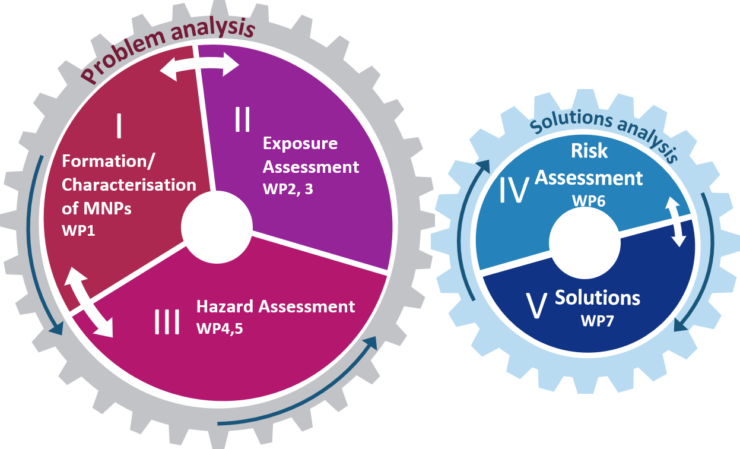The potential effect of micro- and nanoplastics on human health
How can we minimise their health impact?
The research conducted in MOMENTUM aims to unravel the potential human health effects of micro- and nanoplastics (MNPs) and to propose solutions to minimise their health impact. To this end, our research is divided into five pillars which are subdivided in work packages (WPs). This structure enables us to directly address the five main objectives of our project:

Pillar I: MNP Formation
We will focus on the formation of MNPs from important plastic sources by degradation processes and develop methods to identify and characterise MNPs (WP1). These insights enable the generation of reference, labelled and weathered MNPs for testing within the consortium (WP1).
Pillar III: Hazard Assessment
While studies in Pillar II confirm internal human exposure and uptake of MNPs, Pillar III will focus on the direct and immune-related effects of MNPs when crossing the internal barriers of the lung, intestinal, brain and placenta, using in vitro and in vivo models, as well as human blood
samples (WP4). The role of MNPs as novel vector substrates for pathogens will also be studied, in particular immune-related responses of pathogen-loaded MNPs in in vitro lung and enteric models mimicking inhalation or oral ingestion (WP5).
Pillar V: Solutions
We will identify innovations in Pillars I-IV that, taken together with other (international) initiatives, will form the basis for the development of Solution Routes for minimizing the health impact of MNPs. In co-creation with private sector, government, NGOs and citizen representatives, we
will develop the research agenda of the envisioned Dutch Public-Private Partnership (PPP) on MNPs and Health, ensuring long sustainability of the MOMENTUM project and its vision.
Pillar II: Exposure Assessment
In a first ever human biomonitoring study, we will characterise, develop, adapt, validate and apply existing and new analytical methods for analysis of MNPs in complex human matrices including blood (WP2). We will also develop new understanding about the mechanisms by which MNPs cross internal barriers of the lung, intestinal, brain and placenta in vitro and in vivo, including the role of the biomolecular corona of proteins and lipids surrounding MNPs (WP3).
Pillar IV: Risk Assessment
We will develop the first roadmap to comprehensive risk assessment that outlines the key human health safety issues of MNPs, based on results from MOMENTUM and by integrating scientific and policy perspectives (WP6). An important goal of this work is to improve the applicability of research generated in MOMENTUM for risk assessment purposes, building on
insights from the field of nanomaterials (WP6).



